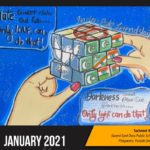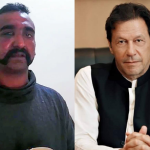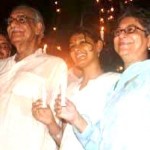#LahoreAttack. India and Pakistan, and the world, must stand united against all forms of extremism
As a teacher, the journey to create a democratic classroom space has been arduous, in the course of which I have made conscious efforts to relinquish control and facilitate student autonomy. Using The Little Prince, in my classroom provided the opportunity to introspect into my ideologies and practices as an educator. This French classic for children by Antoine de Saint-Exupery is a novel that celebrates a child’s imagination and presents a critical reflection of how adults perceive children to be naïve, lacking independent thinking. The book got me wondering, how many times have I stunted my students’ imagination? While I laud democracy and stand for it fervently, I realised that there are moments when I have been autocratic in my educational practices.
After the Lahore attack last Sunday, I revisited the classroom posters created by my students that are emblematic of critical reflection, engagement and their understanding of extremism in Pakistan. This classroom activity was a precursor to a peace-building initiative for which students interacted with schoolchildren in Islamabad. Non-judgemental and untouched by the reductive stereotypes that taint Pakistan’s face in international media, these students embarked upon a journey of engaging and interacting with the “other”.
The guided research task allowed students to evaluate texts, narratives, stories of violence, peace and friendships through the lens of Pakistani media, the jingoistic Indian media and the international media. I wouldn’t say that my students were blank slates or empty pitchers. They recalled scenes from Bollywood movies showing deserts as if that’s the only geographical landscape in Pakistan, or men and children battling fierce weather to undergo military training. They questioned these stereotypes on their own, without my inserting these ideas into their heads. Surely there is much more to this nation, they wondered.
 As children grow older, the transition and loss of humane innocence reflects in how their ideas are gradually cemented. Born free thinkers, children are molded and cast into binaries – good and bad, right and wrong, boy and girl, moral and immoral; we teach them that you cannot negotiate with these binaries in a “grey zone.”
As children grow older, the transition and loss of humane innocence reflects in how their ideas are gradually cemented. Born free thinkers, children are molded and cast into binaries – good and bad, right and wrong, boy and girl, moral and immoral; we teach them that you cannot negotiate with these binaries in a “grey zone.”
My students’ research on understanding domestic issues in Pakistan, the insurgency, rise of extremism and the diverse voices of different ethnic and religious communities, illustrated the image of nation that is as complex as their own. They investigated in depth the critique of Pakistan and its tarnished media image, which is one-sided, singular, fascist, extremist and terror-driven. The thoughts of a mature and inquiring grade 7 student unravel the complexity that is Pakistan while exposing the sexist and racist attacks on its citizens, masquerading as liberalism.
“So many stereotypes are aimed at Pakistan. But what’s true? And more importantly, who builds these stereotypes? Well, it’s mostly the media. Many people feel that all Pakistani women wear burqas. And why do so many people believe this? So many movies set in Pakistan show women wearing burqas at all times, or they show them praying or reading the Quran. The women are never shown going to the mall or something like that. And this should change. All Pakistanis are terrorists. This is another stereotype which is so not true; so many people in Pakistan believe in peace. Take Malala for example; she was shot in the head, but she retaliated and now she is a Nobel Peace Prize winner. Malala, however, is just one such example. Many Pakistanis want peace with India. In fact, some have already attempted. Singers from Pakistan and India have performed together to erase some tension. On Independence Day, a group of Indians and Pakistanis called and wished each other only to realize how there is no difference between Indians and Pakistanis. What stands in the way are these stereotypes, let’s stop promoting these stereotypes, and hopefully less problems will be created. Peace will prevail.”
This questioning attitude is critical. This is a rising voice of dissent and a voice that challenges one’s own media and does not feel entrapped by jingoistic nationalism that demands proof of patriotism in the form of demonising Pakistan. These stereotypes perpetuated through mainstream media lie broken into shards. This affirms my belief in humanity and the idea of innocence.
 When terror was unleashed on school children in Peshawar or the cheery sounds of young souls bursting in joy, celebrating Easter, thinking of school, of friends, or games of hide-seek were silenced, I realized that Pakistan’s bourgeoning minds, holding similar promises of peace were destabilising the mission of terror outfits. One cannot imagine the state of the families in Lahore that have been shred. These families will be sewing together their lifeless existence, as they carry the heavy weight of their lightest coffins.
When terror was unleashed on school children in Peshawar or the cheery sounds of young souls bursting in joy, celebrating Easter, thinking of school, of friends, or games of hide-seek were silenced, I realized that Pakistan’s bourgeoning minds, holding similar promises of peace were destabilising the mission of terror outfits. One cannot imagine the state of the families in Lahore that have been shred. These families will be sewing together their lifeless existence, as they carry the heavy weight of their lightest coffins.
This is why we need to stand in solidarity with Pakistan. This is why it is more important to not dismiss terror attacks in Pakistan, especially in the recent times, as everyday domestic affairs or self-inflicted trauma that they should have to deal with on their own.
It pains me when people say that Pakistan is reaping the fruits of hatred sown in the name of religion. The time has come when India and Pakistan, and the world, must stand united against all forms of extremism. For the sake of our future, for the sake of our children; this is the essence of “Vasudhaiva Kutumbakam” – a Sanskrit phrase from the Hindu Upanishads that means, ‘The World is One Family.’
Tulika Bathija is an educator from Mumbai in search of her Sindhi heritage. She ardently participates in Indo-Pak peace initiatives and hopes to write stories about Indo-Pak peace and communal harmony for children and young adults. Email: [email protected]












